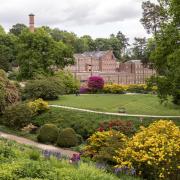Challenges in the Countryside

I was reading a storybook to my children last night that mentioned “running through a flower-filled meadow”. I honestly couldn’t remember when I last saw such a thing. With the pressure on farmers to increase the amount of food they grow to cope with the increasing population, it is not surprising that as much land as possible needs to be put into production. But there are countryside agri-environment schemes to make sure that some of England’s green and pleasant land is flower-filled too.
Millions of pounds are available to farmers and landowners to help protect and improve environment: schemes to encourage wildlife (bats, owls, hedgehogs, and hares), birds, natural wildflowers, and healthy pollinators are all in existence. The Wild Pollinator and Farm Wildlife Package is put together as a collection of scheme options that can benefit a diverse range of insects, birds and wildlife and as well as sowing nectar flowers, winter bird food mixes and increasing flowers on grassland, landowners and farmers have to manage their hedgerows and habitats that may, on first passing, seem unimportant, like humble ditches.
New schemes available from 2015 through The Countryside Stewardship Scheme, working with Natural England, are complex and competitive. One of our roles here at Strutt & Parker is to help farmers and landowners navigate their way through these Tiers of Stewardship Schemes to find the best suited to their land, their hopes and future of the countryside. Strips of land at field margins, or in difficult-to-navigate areas, can be sown with nectar rich flowers to help pollinators thrive; maintenance of hedgerows provides safe havens for songbirds and insects; looking after ponds and ditches will encourage insects – both for pollinating and as food sources for birds; repairing dry stone walls to encourage shelter for bees, slow worms, toads – and even little owls: all these actions can encourage wildlife to survive, to flourish, to reproduce and to become established.
Being topical, applications run on a points-based system: the more points that are scored in an application and the more priorities that are met, the better chance a farmer or landowner has of getting a grant.

For each area of England, there are a different set of priority groups (biodiversity, water, historic environment, woodland, landscape and multiple environmental benefits) dependent on specific features. Natural England has assessed each area for its national significance as to certain species, habitats, plants, or features and those will be the top priorities. For example, in Cheshire we have The Cheshire Sandstone Ridge: priorities include lowland meadows, traditional orchards, ancient and native woodland, and species such as lapwing, tree pipits, flycatchers and slender thread-moss. Then there is the Shropshire, Cheshire and Staffordshire Plain where habitat biodiversity, maintenance and restoration focus includes: floodplain grazing marshes, lowland dry acid grassland, and riparian habitats; for species, corn bunting, curlews, and the wonderfully named ten-spotted pot beetles and swamp-lookout spiders. I have not made those up…
Water matters include everything from river management, to water quality (managing potential pollution from fertilisers, pesticides, manure and run-off), to floodrisk, coastal risk management and soil erosion. Farmers have to be aware of sediment levels, as well as those of phosphates and nitrates, and check those levels in groundwater drinking sources. It is not for the faint-hearted.
For Woodlands, some are protected for their national biodiversity value, some contain special habitat, some are ancient, some house important species: there is a fine balance between encouraging wildlife and managing harmful species (deer and grey squirrels in particular) that can cause huge amounts of damage.
Areas of historical and archaeological importance are a huge responsibility but when on farmland, they can be more of a headache and a challenge! Damage might be caused by ploughing or not dealing with scrub and tree growth. We can help with advice on land management issues, and guide landowners to the appropriate grants and other specialist care. The features one might have include everything from Scheduled Monuments, to Registered Parks and Gardens, from World Heritage Sites to Registered Battlefields. On the slightly “less glamorous” register might be traditional farm buildings and “undesignated historic and archaeological features of high significance which are part of the Selected Heritage Inventory for Natural England…” otherwise known as SHINE! It’s quite a burden – particularly if your traditional farm buildings are no use to your current methods of farming and you’d rather have a nice new shiny shed! Additionally, modern field farming practices could cause irreparable damage to archaeological features – cultivation, harvesting, direct drilling, tillage might have to be avoided in such an area. Sometimes a site is better left to permanent grass, other times, scrub and bracken might have to be removed and managed; there are different management systems for above-ground features, such as standing stones. Sometimes, it is a matter of pure protection and maintaining condition. On top of a lengthy farming day, it is extra workload but having the chance to protect and enhance species, history and countryside brings its own rewards.

Every part of the landscape forms part of an amazing natural patchwork. It is complex and beautiful, and for farmers and landowners, a joy, a responsibility and a challenge. As my grandmother always told me: “Natural beauty takes a lot of hard work”.
Strutt & Parker, 37 Lower Bridge Street, Chester CH1 1RS 01244 354888



























![Stephen Webb [Frank-N-Furter], Richard Meek [Brad], Haley Flaherty [Janet] & cast](/resources/images/128x89/1x/17679473.jpg)
![Stephen Webb [Frank-N-Furter], Richard Meek [Brad], Haley Flaherty [Janet] & cast](/resources/images/180x180/1x/17679473.jpg)
